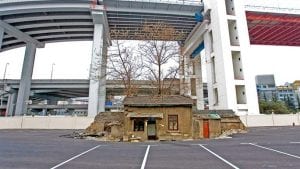 “Nail house” in Shanghai: Lucas Schifres/Getty Images
“Nail house” in Shanghai: Lucas Schifres/Getty Images
Film, music and photography-based ESL/EFL lesson about urbanization and nostalgia
My last post featuring Frank Sinatra’s It Was A Very Good Year reminded me of a grammatical structure I have seldom had cause to teach. Twice in the song we see the modal “would” used not in the conditional context that most students will encounter first, but rather to express habits in the past (“We’d hide from the lights / On the village green”, “We’d ride in limousines / Their chauffeurs would drive”). To build on this, as well as the structure “used to + verb”, to talk about our past routines, there is fantastic song which is also a rich basis for discussion about our relationship to the past, particularly as concerns urbanization and the irrevocable transformation of the natural environment into the built one. The song is Tar & Cement, a one-hit country-soul wonder by Verdelle Smith, written by Lee Pockriss and Paul Vance. Continue reading

